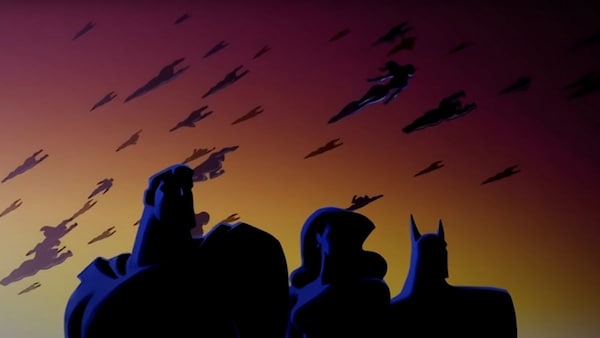Justice League The Animated Series: Revisiting DC’s animated series and the Timmverse 20 years later
Why it is still one of the best superhero team-up adaptations ever made for film or television, and what to expect from the upcoming Injustice animated film

Last Updated: 04.02 PM, Oct 14, 2021
Long before Marvel launched its Marvel Cinematic Universe, which would monopolise global box-office for almost a decade, DC had its own animated universe in the 90s and 2000s which were revered in the same regard as The Godfather trilogy is in feature films. The franchise is often called the Timmverse after Bruce Timms who served as executive producer. It all began when the Batman the Animated Series debuted in 1992, and to date, it is regarded as the most definitive version of the Batman mythos ever created on any medium, and one of the most critically acclaimed animated programs of all time. Kevin Conroy and Mark Hamil (Luke Skywalker himself) immortalised themselves as the voices of Bruce Wayne/Batman and The Joker respectively. Conroy’s choice of modulating his voice to different sounds for his Bruce Wayne and Batman interpretations is something that would be used by Christian Bale and Ben Affleck for their versions of the dark knight.
The success of Batman the Animated Series does not end there, it became among the first comic book adaptations on the screen to inspire new characters and one among them being Dr Harleen Quinzel aka Harley Quinn. In fact, Quinn was inspired by the actress who voiced her, Arleen Sorkin, who would go on to voice the character in countless adaptations. But the show’s most notable accomplishment is how it was able to set the foundation for an expansive interconnected universe that introduced the world to instant classics such as Superman: The Animated Series, Batman Beyond (Batman of the Future), Static Shock, and animated feature films such as the highly-rated Batman: Mask of the Phantasm. It is similar to how Iron Man (2008) set the wheels in motion for the Marvel Cinematic Universe.
The Timmverse peaked in 2001 with the release of Justice League the Animated Series. It featured updated animation with sleeker character designs and world-building whilst keeping the core identity of the Timmverse intact. The show would be yet another feather in the cap for Bruce Timm and the creators of the animated series. For the uninitiated, it could simply be dismissed as a cartoon with superheroes - and for all intents and purposes, it is exactly that. It is an entertainer for kids who love these characters, but a closer analysis of the series will reveal carefully written stories with philosophical subtext layered within the narrative of each episode. There are episodes that deal with socio-political themes about free will, authoritarian and totalitarian governments, equality, class elitism, and scientific theories on wormholes, time travel, and parallel universes - long before Christopher Nolan made it mainstream with Interstellar (2014). The sequel series Justice League Unlimited was just as good, but with a much larger roster of DC heroes which included Black Canary, Green Arrow, Aquaman, The Huntress, The Question, Supergirl, The Atom, and several others.
The series serves a wider demographic like the Marvel Cinematic Universe (MCU), but unlike Disney’s behemoth franchise, it does not resort to a formulaic series of films with cheesy one-liners and toned down themes to transcend through various demographics. One would imagine that this widely acclaimed superhero team-up features the most famous comic book characters of nearly half a century such as Batman, Superman, Wonder Woman, Flash, Green Lantern, Hawkgirl, and Martian Manhunter would translate well into a feature film seamlessly. And that it would dethrone the newfound fame of Marvel’s Avengers, who were nothing more than afterthoughts prior to 2008. Unfortunately, thanks to colossal mismanagement by Warner Bros. the 2017 film titled the Justice League was a commercial and critical failure.
Ironically The Avengers (2012) director Joss Whedon is allegedly responsible for the mess after he replaced Zack Snyder as director for the project. Regardless of one's opinion of the film, there were some very noticeable objective inconsistencies in editing and CGI that warrants the film to be included in the Hall of Shame. Whedon ripped apart Snyder’s original film and turned it into an abomination. Fortunately, Snyder was allowed to release his original cut, due to popular demand, titled Zack Snyder’s Justice League earlier this year. The film has twice the run-time of Whedon’s reshot theatrical cut, with nearly 4 hours, a vastly different narrative, character arcs, cinematography, sound design, and costume design. There could be no arguments that the ‘Snyder Cut’ is a vast improvement and significant upgrade from the 2017 film. Fans of the animated series finally have closure with the fact that there exists a live-action version of the Justice League which ticks all the boxes on what makes a perfect superhero adaptation.
Even though Justice League has a rocky history when it comes to live-action adaptations it has thrived in animated films and TV shows, such as Young Justice, Justice League Dark: Apokolips War, and Justice League: The Flashpoint Paradox. The latest adaptation, Injustice, is expected to release in India on October 19. The animated film is based on the critically acclaimed video game series and graphic novel of the same name about an alternate earth storyline where Superman inadvertently kills Lois Lane and their unborn child after the Joker uses hallucinogens on the man of steel. Superman loses his sanity and subjugates the entire planet under his rule in a totalitarian regime with the support of a few members of the Justice League. Batman and few others are forced to flee underground as they stand in opposition to this new era.

 Premium
Premium